Bill Watts
Well-Known Member
I mentioned in my previous post that this was one of my favourite spots for photography in Singapore, I left Singapore in 2018, but maintain a home there and take my leaves there. The last couple of years have been busy so I didn't get out and about with the camera much, and the Chinese and jJapanese gardens were closed for a couple of years for "refurbishment" Several million dollars later and the gardens reopened just as I returned on leave this year.
Just the ticket to try out a couple of my latest acquisitions, an Olympus FTL and an Olympus OM-2n (the bargain basement one). I suspected the FTL was capping speeds so dropped it off at the Camera Hospital in Singapore, diagnosis confirmed, it was returned to me fixed in 24 hours! They also knocked the dent out of the filter ring on the 50mm f 1.8 lens that came with the bargain basement OM-2n. Can't recommend Camera Hospital enough if you happen to be in Singapore!
So I set out to Chinese Gardens in high hopes.
What a disappointment! the Bridge of Double Beauty is no longer named on the maps, although it is still there, the approach has been blocked off by an exhibition hall and the stone obelisk is no more! Before and after photos below. This bridge was the connector between the Chinese and Japanese gardens, both being situated in lakes.
A new bridge has been built right across the middle of the lake in steel with wooden vertical slats, contemporary style and completely out of place in the gardens. similar style "bus shelters" have also been dotted around the gardens.
a new Plaza with a shop and a restaurant has been built in front of the 7 floor pagoda where previously there was a grassy bank - commercialism at it's best - got to extract maximum coin from the punters.
The gravel and stone paths have been replaced with white concrete paths that look so out of place.
Although the gardens were only inaugurated in 1975, designed by a Taiwanese Doctor in the style of the Northern Imperial Chinese and Japanese of similar period, they were outstanding examples of the genre.
Now they are just like anywhere else. Can always trust someone to ruin a perfectly good design in the name of progress.
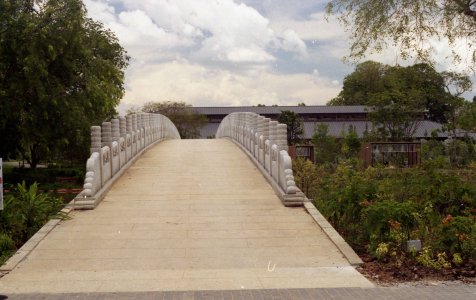
Approach to the bridge of Double Beauty 2024

Approach to the Bridge of Double Beauty taken from the position as in the infra red photo previously posted
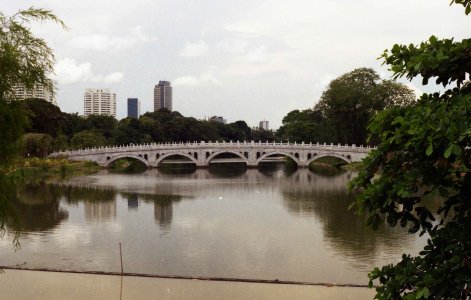
The Bridge of Double Beauty.....
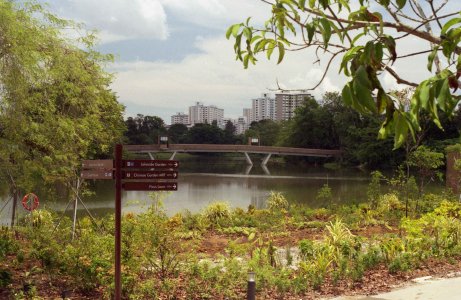
and it's replacement!
Fortunately some of the old charm remains, the Bonsai gardens seem to have escaped unscathed
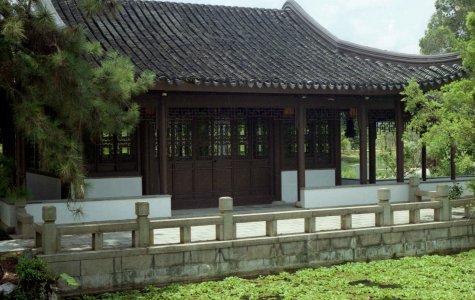
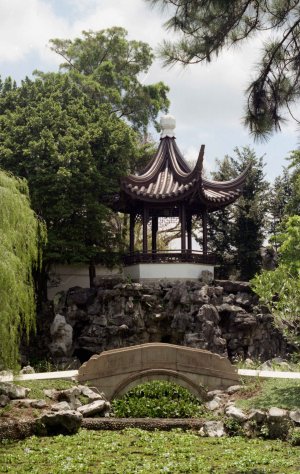
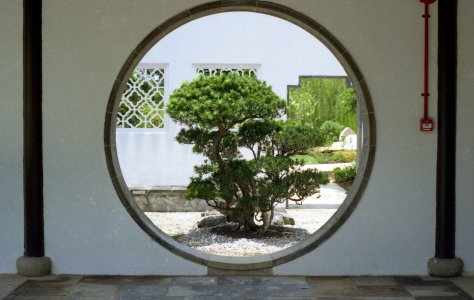
although they could have done something about the fire alarm!
All the photographs were taken with the Olympus FTL, on Kodak ProImage100 film and scanned using an Epson Perfection 4490 scanner at 3200DPI as 48bit tiffs with Epson Scan I software. JPGs generated using Faststone software.
Just the ticket to try out a couple of my latest acquisitions, an Olympus FTL and an Olympus OM-2n (the bargain basement one). I suspected the FTL was capping speeds so dropped it off at the Camera Hospital in Singapore, diagnosis confirmed, it was returned to me fixed in 24 hours! They also knocked the dent out of the filter ring on the 50mm f 1.8 lens that came with the bargain basement OM-2n. Can't recommend Camera Hospital enough if you happen to be in Singapore!
So I set out to Chinese Gardens in high hopes.
What a disappointment! the Bridge of Double Beauty is no longer named on the maps, although it is still there, the approach has been blocked off by an exhibition hall and the stone obelisk is no more! Before and after photos below. This bridge was the connector between the Chinese and Japanese gardens, both being situated in lakes.
A new bridge has been built right across the middle of the lake in steel with wooden vertical slats, contemporary style and completely out of place in the gardens. similar style "bus shelters" have also been dotted around the gardens.
a new Plaza with a shop and a restaurant has been built in front of the 7 floor pagoda where previously there was a grassy bank - commercialism at it's best - got to extract maximum coin from the punters.
The gravel and stone paths have been replaced with white concrete paths that look so out of place.
Although the gardens were only inaugurated in 1975, designed by a Taiwanese Doctor in the style of the Northern Imperial Chinese and Japanese of similar period, they were outstanding examples of the genre.
Now they are just like anywhere else. Can always trust someone to ruin a perfectly good design in the name of progress.

Approach to the bridge of Double Beauty 2024

Approach to the Bridge of Double Beauty taken from the position as in the infra red photo previously posted

The Bridge of Double Beauty.....

and it's replacement!
Fortunately some of the old charm remains, the Bonsai gardens seem to have escaped unscathed



although they could have done something about the fire alarm!
All the photographs were taken with the Olympus FTL, on Kodak ProImage100 film and scanned using an Epson Perfection 4490 scanner at 3200DPI as 48bit tiffs with Epson Scan I software. JPGs generated using Faststone software.
Last edited:
